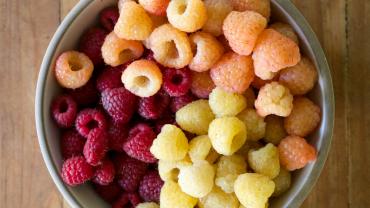
Are you scared of fruit? Have health headlines about sugar and fructose—the “fruit sugar”—made you terrified to bite into an apple even though back in your grandmother’s time the old adage said “An apple a day keeps the doctor away?”
Owing to the increasing popularity of low-carbohydrate diets for weight loss management of metabolic syndrome and other health goals fruit has garnered a bad reputation. After all even though fruit contains “natural sugar” it’s still sugar and maybe you feel compelled to banish every last gram of it from your diet. There’s certainly merit in reducing intake of large amounts of juice and dried fruit particularly if you are looking to lose weight or improve your blood sugar management. And while canned fruit in syrup is best left on the grocery store shelf some fruits in their whole form can absolutely be part of a healthful diet. So before you drive yourself crazy trying to avoid every visible molecule of natural sugar consider berries.
Fear-mongering about excess fructose consumption has resulted in otherwise wholesome and nutritious fruits being banished from many people’s diets. Some fruits are higher in fructose than others. Grapes apples and bananas are slightly higher in fructose while in general berries have a low content. Along with their relatively low amount of fructose boldly colored berries are loaded with health-promoting phytonutrients and antioxidants but the best reason to include them in your diet is the simplest: they’re delicious!
Among the berries that shine at summertime farmers’ markets are raspberries. A whole cup of raspberries (approximately 123g or 4.3oz) amounts to just 15g of total carbohydrate 8g of which are fiber making raspberries a great choice for when sweet cravings rear their heads even if you’re watching your sugar intake. They have an extremely low glycemic load while providing 54% of the daily value (DV) for vitamin C 12% of the DV for vitamin K and 41% of the DV for manganese. All that with less than 3g of fructose—a far cry from chugging a can of soda! The nutrient content of raspberries can be affected by growth and storage conditions stage of ripening and type of cultivar. In general though ripe raspberries contain considerable amounts of lutein and tocopherols.
Raspberries make excellent additions to smoothies unsweetened plain yogurt or kefir and of course they’re great as a snack all by themselves or with a little splash of cream or coconut milk. But a sweet burst of flavor isn’t all these ruby and dark purple-colored berries are good for. Red and black raspberries have demonstrated antimicrobial activity against some human pathogens such as Corynebacterium diphtheria (which causes diphtheria) as well as Moraxella catarrhalis an organism responsible for some types of ear and respiratory tract infections.1 In rat models of arthritis red raspberry extract reduced paw edema (swelling and fluid retention) as well as clinical signs of arthritis such as soft tissue swelling and formation of bone spurs leading to reduced degeneration of the joints.2
The antioxidant and anti-inflammatory properties of raspberries may make these sweet berries somewhat helpful in the fight against cancer. Berry extracts including black and red raspberry may help reduce the growth of cancer cells in breast colon and prostate cancers.3
Some animal studies evaluating the health effects of black raspberries have used freeze-dried fruit samples which indicates that the bioactive compounds remain viable through this method of preservation. This is good to know since freeze-dried (and frozen) berries are available year-round even when their fresh ripe counterparts are not. Frozen berries can be added to smoothies and baked goods just as readily as fresh.
The word “raspberries” likely brings to mind images of fuchsia or dark purple berries spilling over a green pint container or peeking out from neat plastic holders at the supermarket. But if you visit a farmers’ market in summer you might be surprised to come across golden raspberries. They have a slightly more mild flavor come in a pale yellow-orange color and can be used in any recipe that calls for red or black raspberries.
Sources: